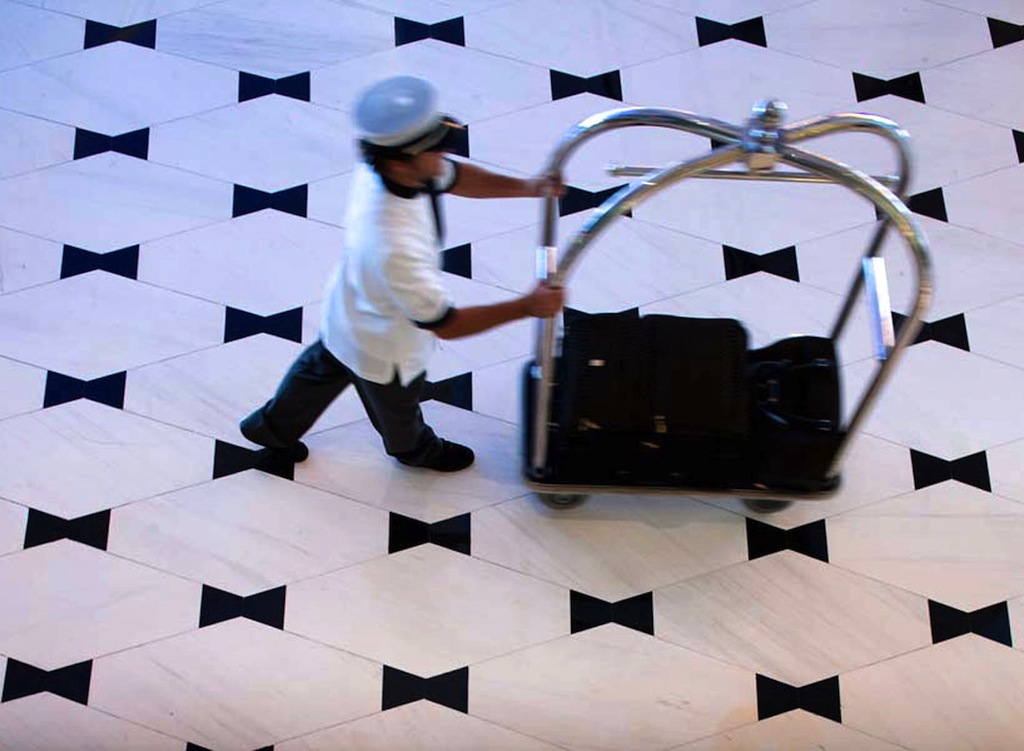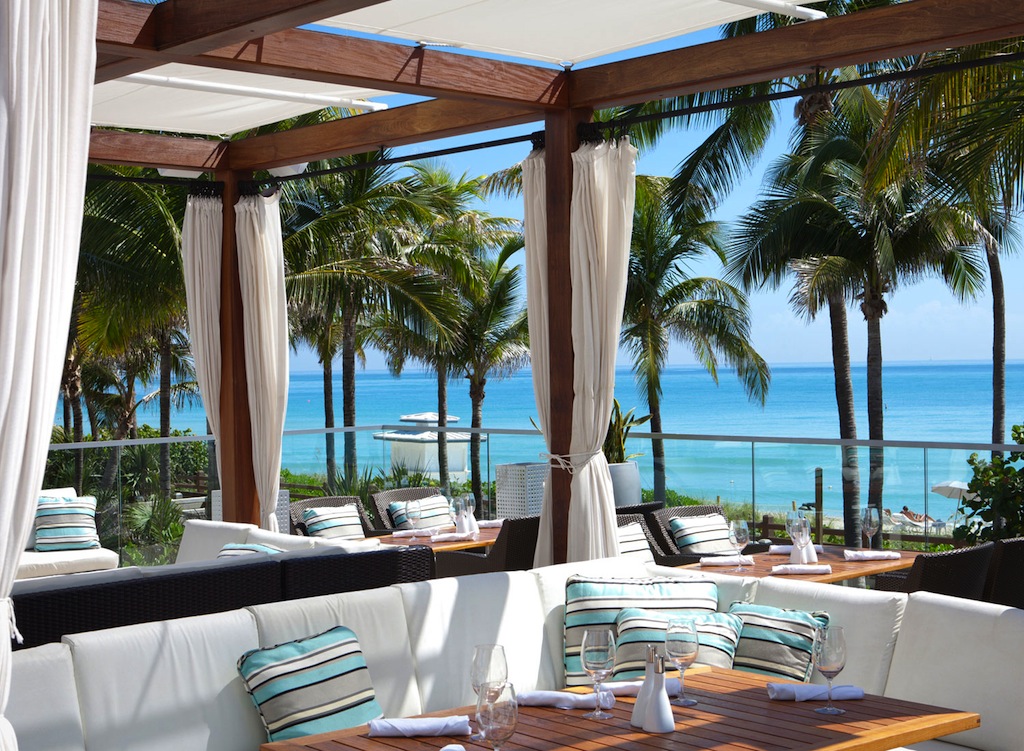Sometimes a shot of Botox just ain’t enough. What’s needed is a complete makeover from top to bottom. And in the Land of Extreme Makeover, aka Miami Beach, the latest billion-dollar bombshell to showcase her extreme transformation is that oft-denigrated Morris Lapidus chef d’oeuvre the Fontainebleau.
Once reviled for its slap in the face of staid modernism with its emblematic curves, cheese holes, and circles, the Fontainebleau has long held a fabled place in the history of Miami Beach – and therefore, in the history of American leisure and culture.
It was in 1952, right on the cusp of commercial aviation, that hotelier Ben Novack purchased the Firestone mansion on upper Collins Avenue and appointed Lapidus to create the largest hotel in Miami Beach. As Lapidus explained in his autobiography, Too Much Is Never Enough, American culture at that time was in the grip of Hollywood – and so Lapidus created a movie set and let the guests be the players.
When the Fontainebleau opened in 1954 (the same year as Judy Garland’s “A Star Is Born”), more than 1,600 people attended the inaugural ball – including the mayor of Fontainebleau, France.
Throughout the Fifties and early Sixties, the Fontainebleau played host to every major entertainer and celebrity, from Presley, Garland, and Gleason, to Dietrich and the Rat Pack. The resort was the setting for Jerry Lewis’s The Bellboy, as well as Goldfinger – but by the time of the filming of The Bodyguard in 1992, the Fontainebleau was less a bombshell than a dowager clinging to faded glory.
At some point near the end of the last millennium, we found ourselves at the Fontainebleau for the first time, seeking to rent a car – and what we found was, frankly, alarming. The abandoned rental car desk was in the middle of a fusty, carpeted lobby, and there was an elderly Austrian man, also waiting for the nasty employee to return, who started conversing with us, imitating the irritated rental car clerk in his heavily accented voice: “Pithy? She thinks she’s pithy? I’ll show her pithy.”
Fast forward to 2008 – where not a vestige of that faded Fontainebleau remains. Instead, as soon as your car heads around the Fontainebleau’s stately porte cochère and the valets, attendants, and bellboys amass, it’s immediately evident that you’re in the hands of a team of professional players. These are employees who seem genuinely pleased to be witnessing the renaissance of an icon. Thoughtful and courteous, as well as obscenely attractive, without any of what is sometimes referred to as Miami Beach attitude, the people who front the reception desks and concierge serve as an exemplar to the hospitality industry as a whole.
Stripped down to steel studs and bare concrete and then completely rebuilt with an almost complete reimagining, the Fontainebleau shimmers with the impact of every dollar of its $1 billion dollar makeover. Talk about making an entrance – back on the world stage!
From the moment you step into any of the Fontainebleau’s various public areas – and let’s start with the famous central lobby, with its world renown Staircase to Nowhere – you can’t help but feel as if Lapidus has done you right and made you a movie set designed to highlight all your best attributes.
You feel it in your step; you see it in everyone catwalking around you. You’re working your shades as you stroll across the famous black bow-tied marble floor; you’re creating a look. You’re part of the whole movie that’s surely being filmed. This is life on celluloid – and it’s brilliant. It’s not surprising that the Fontainebleau’s first re-opening bash was the celebrity-laden Victoria’s Secret fashion show in late November.
Perhaps what is most inspiring about the Fontainebleau’s reconfiguration is the manner in which the signature Lapidus motifs have been retained – floating ceilings, crystal chandeliers, sweeping curves -and brought forward into 2008. This is as loving a reconsideration of an architectural monument as any since perhaps the reclaiming of Manhattan’s Grand Central Station – another public stage set and cultural touchstone.
Spread out over twenty-two eye-popping, oceanfront acres, the Fontainebleau resort showcases two new towers, the 37-floor Trèsor and the 18-floor Sorrento, as well as the original Fontainebleau’s Chateau and Versailles, both of which have been completely reconceptualized. Utilizing a team of eight designers, architects, and artists who immersed themselves in Lapidus’s original vision, the Chateau’s oceanfront rooms, for example, are a vision of contemporary serenity, even as they nod to Lapidus’s favorite sculptural details.
Furnished with rattan table and chairs, as well as two rattan chaises, the oceanfront terrace of our suite could easily have hosted a cocktail party for twenty. Alas for our friends, we were too selfish – and chose instead to indulge ourselves in sumptuous shelter magazine fantasies of the high life. (Insert photo – of two style mavens swathed in white waffle spa robes, peeling an orange, drinking champagne…)
Few things in this world are as inspirational as awaking to the sound and sight of the surf breaking on the shore – and our Chateau suite ruined us for any alternate life. We’re talking a bathroom that could’ve housed a Bentley, with a walk-in shower that could’ve accommodated six (not that we attempted, mind you…)
Equally alluring was the suite our friends had in Sorrento Tower. Ranging in size from a studio apartment to a Manhattan penthouse, the Sorrento suites include flat panel television, kitchenettes with granite countertops, marble bathrooms, jet tubs, walk-in showers, and spacious balconies. You haven’t lived until you’ve seen a tropical sunset wash over the Miami skyline from your Sorrento tower room.
The problem? Who wants to leave rooms and suites such as these? Though the rest of the resort beckons, tempts, and cajoles, it’s sometimes difficult to pull oneself away from such commodious accommodations. But you must! There are restaurants awaiting – and we’re not talking just any old restaurants.
The eleven dining choices peppering the resort include those of such renown New York chefs as Scott Conant (L’Impero, Scarpetta) and Alfred Portale (Gotham Bar and Grill), as well as – get ready for this – Alan Yau, chef of the only Michelin-starred Chinese restaurant in London, Hakkasan. Also coming soon is La Còte, inspired by the Còte d’Azur: a chic, two-level restaurant situated by the beach and pool and featuring an open-air restaurant on La Còte’s upper level as well as tapas-style snacks.
Apart from the eleven restaurants and lounges, and a 40,000 square foot spa, there’s also the pool. No, not just any pool, but a free-form pool evoking Lapidus’s lobby floor bow ties. Arguably the heart of the Fontainebleau, the pool is where you’ll find yourself surrounded by “walls of water” as you await the emergence from the ocean of the latest James Bond.
Beyond the grand statements, it’s the attention to detail that proves so alluring. Book a wake-up call or dine in your room by utilizing that shiny white iMac on the desk in every hotel room – personalized to every guest. The Fontainebleau delivers on the promise of a “paperless” hotel, by hooking up with Apple, to ensure all guests are connected whenever and wherever they wish to be – and if you’re like us, and always irritated by the numerous paper doo-dads and advertising that greets you in your hotel room – then you can appreciate entering a room devoid of that useless paraphernalia. The iMacs are standard in each room, free to guests, and allow you to simply plug-in and play music from your own MP3 player.
The linens, created exclusively for Fontainebleau, are all sewn with an in-house ’Made For Fontainebleau’ label. Bath sheeting is supple enough for a newborn – and large enough to swaddle a camel! Toiletries by Lapis, the in-house label for the Fontainebleau’s spa, Lapis. For as Morris Lapidus well knew – in constructing a movie set, it’s the numerous details which create a whole.
What was once Sinatra’s favorite haunt, the Tropigala Lounge, has now become LIV (think Roman numerals – 54 – the year of Fontainebleau’s opening), a marquee nightclub that has already hosted the likes of such world-class deejays as David Guetta and Tiesto. Able to hold its own against some of the top NYC and LA clubs in the visual category, LIV features deep blue lighting and a vaulted ceiling, which creates the impression of a starry night. A super-chic VIP area overlooks the dancefloor. LIV has already scheduled Sharam of Deep Dish fame and members of Maroon 5 for upcoming gigs. Check-out www.livnightclub.com for more info.
According to Jeffrey Soffer, the Executive Chairman of Fontainebleau Resorts, LLC, “We are moving the resort into the future…to create a 21st century showplace [for] a new generation of tastemakers.” With the opening of the $3 billion Fontainebleau Las Vegas set on 25 acres of the Strip scheduled for the autumn of 2009, Soffer would appear to be leaving nothing to chance in terms of snaring those tastemakers. But at least for now, it’s all about the Fontainebleau, the once and always original on Collins Avenue in Miami Beach.
As Lapidus put it best, “I’m selling a good time” – and ever since then, and now more than ever, Miami Beach has been the better for it. Vive le Fontainebleau!
For information and to make a reservation visit Fontainebleau






























